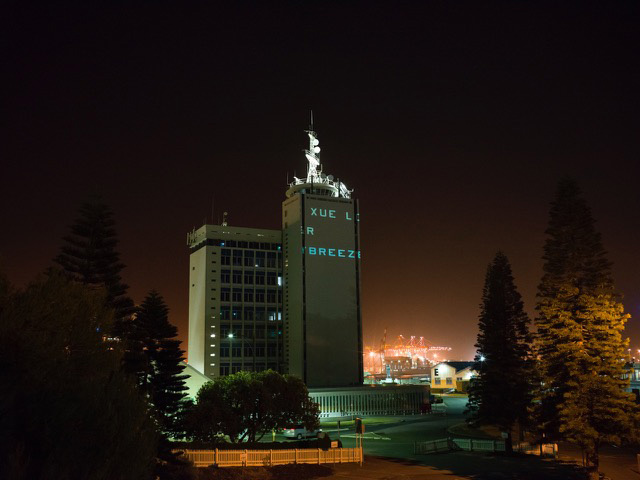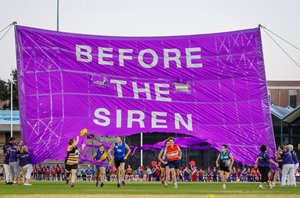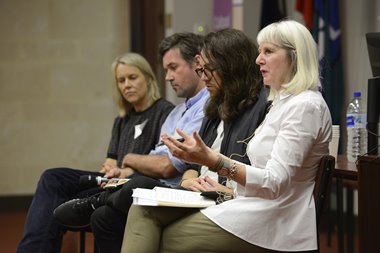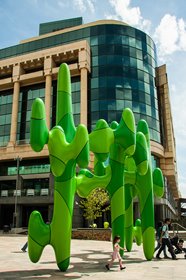 4 Minutes Later:
4 Minutes Later:
On Disrupting Stasis
Words by Carly Lynch
Home Town: artist & community ambition on an international stage
An Artsource & UWA Cultural Precinct symposium as part of the High Tide 17 Festival
My hometown of Dunsborough is located on Cape Naturaliste in Western Australia’s South West. It is known as Quedjinup, meaning ‘Place of Women’ for the Wardandi people — the true owners of the land. It is flanked by the Indian Ocean on both sides. Today, the tide at home is on the rise and will peak at 10:31pm at 0.9m. In Fremantle, known as Walyalup to the Wadjuk Noongar custodians, it is predicted to peak four minutes later at 1.05m.
Home Town was a curious title for this symposium. You might think it would discuss how the speakers draw upon how their upbringing and identity in their artistic and/or curatorial practice; and some did; but many set out to do something quite different.
This symposium largely left the context of Perth behind, in favour of discussing the aesthetic and conceptual concerns of ambitious international projects. Tess Maunder discussed her role as a co-curator of the 11th Shanghai Biennale Why Not Ask Again?; whilst Gary Dufour lectured on his favourite public and socially engaged artworks and Ian Strange spoke of the paradox of making interventions in different communities for a global art audience.
 As a Perth-based emerging artist I make work about the ways that certain histories are framed; claimed and preserved. I am interested in how we can use art to discuss the problems facing our neighbourhoods and nations. What I found most inspiring about the Home Town symposium, was a discussion of projects which arose from socially engaged practices. Rather than a lasting, permanent artefact, the projects were ephemeral or unfolding gradually over long-time frames; grappling with troublesome histories, generating stories and reigniting lost cultural practices. They involved hybridity; cross-cultural exchange; conversation; learning and carried significant emotional weight.
As a Perth-based emerging artist I make work about the ways that certain histories are framed; claimed and preserved. I am interested in how we can use art to discuss the problems facing our neighbourhoods and nations. What I found most inspiring about the Home Town symposium, was a discussion of projects which arose from socially engaged practices. Rather than a lasting, permanent artefact, the projects were ephemeral or unfolding gradually over long-time frames; grappling with troublesome histories, generating stories and reigniting lost cultural practices. They involved hybridity; cross-cultural exchange; conversation; learning and carried significant emotional weight.
Anne Loxley spoke about socially engaged practice and highlighted Lara Thoms and Snapcat’s recent collaborative, ephemeral performance, Before the Siren (2017), that she co-curated. She spoke of it championing local female community groups, in the context of the launch of the women’s AFL league. It was a welcomed grass-roots example of giving voice to community whilst raising the artist’s broader concerns around female visibility.

Likewise, the MCA’s C3 West Blacktown Native Institution Project (2014-18) was a powerful example of site-based engagement, where the past, present and future of the former mission site was confronted through art, corroboree, storytelling and workshops…reclaiming that which had been whitewashed.
A range of ‘local International’ projects were discussed by Jonathan Kimberley who is currently the Director of GASP (Glenorchy Art and Sculpture Park in Hobart), Tasmania. He has spent extensive time collaborating with and facilitating opportunities for Indigenous artists in communities. Unmapping the End of the World (2014-15) was a large group exhibition which arose from the intercultural exchange on journeys of 14 artists to 3 UNESCO World Heritage Sites. This project acknowledged the importance of collaboration, conversation and the sharing of knowledge between cultures.
Also engaging with site and community was Martu man Curtis Taylor’s video Caatinga — Milirripa: Spinifex Resin — Keeping Everything Together (2015). Elders on Martu country, in Australia’s Central Desert, voiced their anxieties over the lasting effects of uranium mining. This was juxtaposed by showing the anxieties surrounding relocation of Pankararu Indigenous communities in the Pernambuco State, Brazil. This screening gave real insight into the worries of the elders in each community, not possible without Taylor’s respectful interaction, documentation and dissemination.
Taylor’s hometown hums through his work, anchoring and solidifying his purpose.

Despite my focus on the latter speakers and their projects, much of the discussion of the day reflected projects in the public-art mode. Margaret Moore raised the point that this city tends to ‘fill’ spaces with ‘things’; stifling the visibility of relationships between public artworks and their surrounds. Lisa Roet cited the tendency for public art commissions to be won by works sporting the ‘Twisted Metal Effect’. James Angus mentioned being drawn to a certain robustness of form due to his work’s public placements.
The success of High Tide 17 appears to be in its hybrid nature: it is not one thing, nor is it in one mode, one location or for one audience. It is a multidisciplinary arts festival, offering a multiplicity of sights, experiences and learning opportunities to a multiplicity of people (I would argue, everyone).
It evokes a diverse range of local and global voices; all of whom were grappling with the port-side location. It is a sequence of disruptions, which speculate about Fremantle’s past, present and future. It is a festival for the times and I hope it can set a precedence not only for artistic ambition in our city, but also serving as a reminder for funding bodies that ambitious site-based and socially-engaged works need to be supported.
I wonder what our State would look like if such statutory schemes as the Percent for Art Scheme were replaced with different kinds of schemes, ones which could allow many artists to respond to sites as they changed over many years, through performative, ephemeral, and multidisciplinary forms?
Carly Lynch is an emerging artist and arts worker currently living in Perth. She is based out of Gotham Art Studios and is a part time sessional academic and studio technician at Curtin University’s School of Design and Art.
Images:
-
Jo Darbyshire, Ships in the Night, High Tide 17, 2017. Image courtesy of High Tide 17.
-
Lara Thoms & Snapcat, Before the Siren. Presented by Perth International Arts Festival 2017. Image supplied courtesy PIAF. Photograph: Jessica Wyld Photography.
-
Margaret Moore speaks during Home Town symposium, 2017. Photographer: Paul Parin
-
James Angus, Grow Your Own, 2011, Steel, aluminium, and polysiloxane paint, Forrest Place, Perth. Photo: Sebastian Adams. Image courtesy of the artist and Roslyn Oxley9 Gallery, Sydney.
Home Town
Artist and community ambition on an international stage
An Artsource and UWA symposium.
For more information about this event, click here >